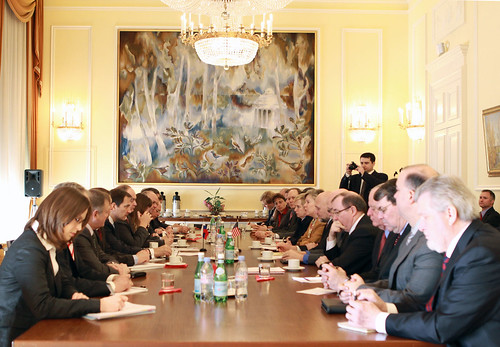When learning the art of effective business negotiation, there are various techniques and approaches you can take to improve your negotiation effectiveness. One of the crucial elements is learning to read body language and the non-verbal communication clues that the other person is giving to you when discussing business. It's estimated that over 70% of communication is non-verbal and can be picked up by accurately reading body language if you know what you are doing.

Watching every move
One of the most valuable lessons for interpreting body language correctly in business negotiations is the ability to tell whether or not a person is telling the truth. The reader must take care not to stare too overtly, but pay attention to subtle clues as the conversation evolves. Stick to friendly and non-threatening eye contact and keep your own body language neutral and welcome - avoid crossing your arms or looking threatening.
Two stages
Firstly you should watch the other person's mannerisms during the initial friendly stage of the conversation when you are breaking the ice and getting to know each other. Build a rapport whilst watching carefully as this will give you the baseline information about their behaviour and it does take time to be adept at it. You will then be able to see whether their behaviour starts to change visibly once the negotiation stage begins. A skilled reader of body language will immediately be able to tell if the other person is putting on an act.
Examples of this type of body language are seen in games such as poker - players who behave in aggressive and brash ways, hurling their chips onto the table, may be masking the reality of a weak hand. For business execs who are over talking and demonstrating behaviour such as loud backslapping may actually have very little to offer in a negotiation situation.
Clues to get the upper hand
Experts suggest that a person's face and hands are the main things to look at when negotiating. Tics such as lip biting, hair twirling or pulling, rapid eye blinking, throat clearing and face rubbing all suggest distress and a person on the back foot. A person who starts to breathe more rapidly may also not be telling the truth - look at the rise and fall of their shoulders for the clue.
Even those who are skilled in the art of negotiation and expression masking may still give away signs of deception through their bodies - such as rubbing their nose, covering their mouth when they talk and leaning away from the other negotiator. If you see these signals during a critical point in the negotiations, you may have spotted the signs of a lie. Experts believe that these signals are non-verbal signals of guilt!
Building rapport
You can also use your own body language to help lead the negotiations in the right direction. If you let your palms face out and use expansive welcoming gestures, you will come across as being open and honest. Also wear clothing that makes you look competent and assured without being intimidating. Keep eye contact to show that you have nothing to hide - if you find it hard to look at someone's eyes directly then look at a point on their face. With groups make sure you look at everyone, particularly the decision makers.
Cultural differences
Bear in mind that different cultures have different norms. For example, an American may be more comfortable standing closer to another person in negotiations than a European person. Take care to understand these norms before you negotiate.
No comments:
Post a Comment